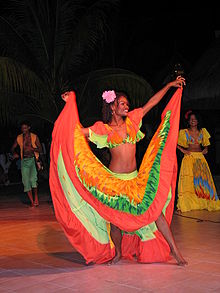Sega (music)

Sega ( French Séga ) is a dance music style that is widespread on the islands of Mauritius and Réunion (the Mascarene Islands ) as well as on the Seychelles . It originated from the traditional folk music of Mauritius and Réunion with influences from European dance music such as polka or quadrille . Sega is often played in the traditional folk dance of Réunion. The modern version is often mixed with other genres, for example reggae or jazz .
Sega music originally comes from the Mascarene Mountains. In the meantime it is also widespread on other islands, as this form of music spreads very strongly in the region of the Indian Ocean.
The origin of Sega music
Sega originated in the 18th century on the islands in the western Indian Ocean, as a mixture of European and African culture. Traditional instruments are the raft rattle maravanne , the frame drum ravanne , the triangle and the musical bow bobre . Originally it was improvised music that was supposed to express the suffering of an enslaved population with strong, emotional elements. It was also used as funeral music and for traditionally driving out devils . Sega is mostly seen as typically Mauritian.
Modern forms
Although it is mainly Reunionese and Mauritian music, Sega music has now also spread to the Seychelles , the Comoros , Mayotte , Rodrigues Island and parts of the coast of Madagascar .
Seggae
Seggae is a combination of Sega and Reggae , a Jamaican type of music that is known in the regions of origin of Sega. Seggae musicians include Ras Natty Baby and Sonny Morgan, as well as the late singer Kaya .
Variations of the individual islands
On the island of Réunion, a slower dance music genre, Maloya , is played alongside Sega , which is not identical to Sega. In Mauritius Sega Ravenne is played, in contrast to Maloya with a much more pronounced bass. The Sega tambour (or sega accordion ) is common on Rodrigues and is significantly faster compared to the other variants. Sega Tambour is mostly sung by women, with only one couple dancing, accompanied by clapping or improvised percussion instruments such as table legs or glasses. Seychelles Sega is called Moutia and is similar to the Sega of Réunion. Seychellois music is heavily influenced by western ballads and especially country music .
literature
- Carsten Wergin: Kréol Blouz: Musical staging of identity and culture . (with music CD). Böhlau, Cologne / Weimar / Vienna 2010, ISBN 978-3-412-20442-6 .
Web links
Individual evidence
- ↑ Brigette des Rosiers: Ile de la Reunion: musiques et identité . In: Canadian Journal for Traditional Music . 1992. Retrieved December 17, 2009.
- ^ Edward Alpers: Recollecting Africa: Diasporic Memory in the Indian Ocean World . In: African Studies Association (Ed.): African Studies Review . 43, No. 1, April 2000, pp. 83-99. JSTOR 524722